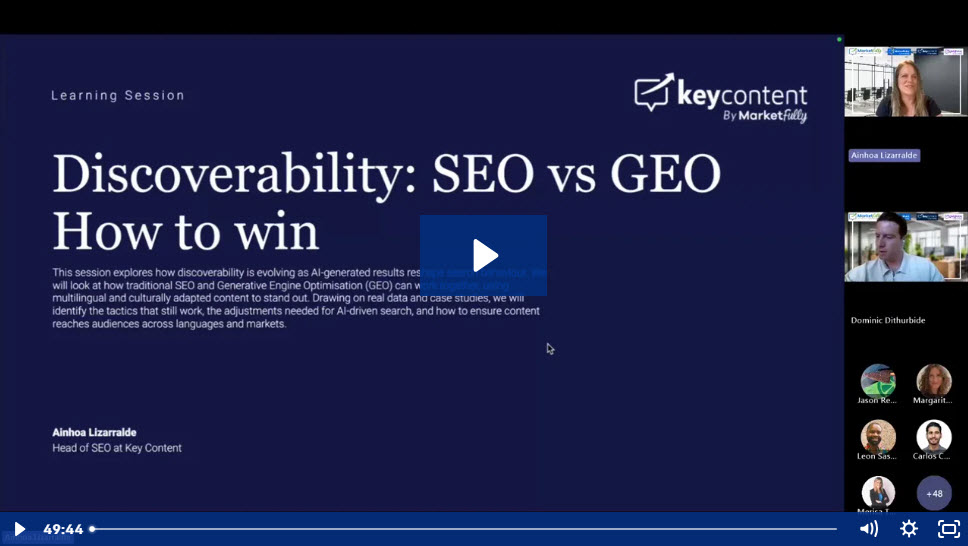As LLMs gain popularity, and the more we experience AI Overviews or other AI-generated summaries, content is increasingly being asked to improve, while drawing on the same high-quality content that traditional SEO has always rewarded.
Actually, Google and other industry experts confirm that the fundamentals of SEO are still the same, and still means creating relevant, authoritative content that meets the user intent and is shown on a trustworthy site. What makes most of the difference today is that search engines and AI assistants show their content differently, often in-line or via rich widgets, but the information is pulled from reliable sources, which you could be one of, if you stick to the right strategy.
AI systems rely on clean, structured, and accessible websites to interpret and repurpose content in generative results. So, marketers need to align their SEO best practices with user experience (UX) principles to make sure content is discoverable in classic rankings and AI-generated answers.
This article explores how core SEO principles still form the backbone of visibility in an AI-driven landscape, how SEO audits are evolving into “GEO” audits, and which technical and UX factors now demand extra attention.
Key takeaway: Technical SEO hasn’t changed in principle, but its role has expanded. It now makes sure content can be surfaced in both search results and AI overviews.

Keeping continuity through SEO audit to GEO audit
Thanks to the introduction of Generative Engine Optimisation, auditing websites now requires you to ask a few different questions. When traditional SEO audits are done, we ask if Google can crawl and index the site and if the content is structured well enough for search. With generative AI, an additional GEO audit is emerging that asks, “Can AI-driven engines read and cite this content in their answers?”.
What this means is that many existing audit checks still apply, like crawlability, site speed, canonical tags, etc., but with a new twist. The twist is, your content must be traditionally findable, but must also be understandable and trustworthy to AI.
GEO doesn’t scrap SEO fundamentals, but rather, it emphasises and extends them. Familiar audit items like structured data, content quality, authoritativeness, and site performance are still critical, but now with the added goal of being chosen in AI answers.
Today, technical audits prioritise these three things:
- Structured data and rich snippets
Add clear schema like FAQ, How to, and Product so AI can extract answers fast. Search Engine Land says LLMs favour structured data because it reduces ambiguity and speeds extraction. Match the markup to the visible page content and validate it. - Performance and core web vitals
Improve page speed and visual stability. Pages with quick LCP and low CLS appear more often in AI summaries. Slow or unstable pages risk being skipped by generative crawlers. In GEO, speed can decide whether a page gets included or not. - Content clarity and hierarchy
Organise content so machines and people can scan it. Use logical URLs, correct H1 to H6 order, bullet lists, tables and semantic HTML. Short paragraphs and clear headings make it easier for LLMs to find and extract answers.
The technical elements that drive GEO success aren’t new. They build on SEO fundamentals like schema, performance, structure, and infrastructure. But nowadays, these are deciding factors between being featured and being forgotten.
Key takeaway: GEO audits build on SEO audits. They aren’t new checklists, but new lenses where the same technical factors matter, with higher stakes for AI search visibility.
UX at the Core of SEO: Clarity and intent with UX at the core of SEO
Although user experience (UX) has always been an integral part of SEO, it’s never been as central to it as it is now. Today’s AI-driven search heavily rewards content that is crystal clear and satisfies user intent in a clear way. Both Google and industry experts emphasise that search, whether classical or AI, must ultimately serve human needs, so clarity and helpfulness are at the top of the list.
AI systems favour concise, factual, and well-structured content. So, keyword-stuffed marketing fluff is much less valuable than clear, straightforward language. Google also reminds creators to focus on helpful content and user intent.
Technical checks are still very important, but we apply them with a user focus. Crawlability and canonicalisation still matter, but there needs to be a focus on where the key answer appears on the page. Fast loading, responsive layouts, and simple navigation are also factors that help users and make content easier for AI to extract.
Content teams should write in a direct, factual style and structure pages so the intent is obvious. Use clear headings, short paragraphs, lists, and Q and A blocks to bring up answers quickly. Accessibility features like alt text and semantic HTML can help to improve reach and help machines understand context.
Key takeaway: Technical SEO now underpins UX. Fast, accessible, and clearly structured pages satisfy both crawlers and users, aligning with AI’s focus on intent.
Key Technical and UX Factors for GEO Optimisation
The technical and UX checklist for AI-aware SEO is comprehensive but grounded in known principles. Key factors include:
- Crawlability & indexing: Make sure search bots and AI crawlers can reach all of the important pages. This means properly configured robots.txt and XML sitemaps, correct use of canonical tags, and no vital content hidden behind login walls or excessive JavaScript. Strong internal linking, like bi-directional links between related content, can reinforce topical authority and help crawlers and LLMs understand your site’s structure.
- Page speed & core web vitals: Load time and stability are now a (dis)qualifying factor, where modern AI engines may skip slow or heavy pages. The Core Web Vitals, especially LCP (loading speed) and CLS (visual stability), directly affect AI visibility. Best practices like compressing images (WebP/AVIF), eliminating render-blocking resources, and aiming for TTFB <200ms all increase the chances that AI will include your content.
- Structured data (schema markup): Strong snippets help search engines and AI by clarifying the page content. In standard SEO, schema has always aimed to remove ambiguity about page topics. In the AI context, structured data’s value is amplified, with LLMs using it to match queries and extract answers. Priorities include FAQPage, HowTo, Product, Organisation, and Article schema with author details; each signals concise answers or trust cues (e.g. author names) that AI looks for. Always keep schema up-to-date and synced with on-page text: outdated or invisible markup can erode trust.
- Accessibility & clean HTML: Both humans and machines need clear text, rather than hidden or convoluted code. Avoid burying important content in images, carousels, or heavy scripts. Google explicitly warns that visible content and structured markup must match. Alt text on images, descriptive captions, and semantic HTML, like tables, lists, and headings, help users and AI. As Key Content advises, include author bylines and profiles (E-E-A-T), use alt tags, and follow accessibility guidelines to improve your credibility.
- Content hierarchy & clarity: Organise information so machines can parse it logically. Use short paragraphs, clear headings, bullet lists for steps or definitions, and labelled tables when appropriate. This makes answers easier to extract.
When you make sure your website is optimised for crawlability, speed, schema, accessibility, and clear structure, you’ll be laying the groundwork for both high rankings and AI visibility. As Search Engine Land notes, “if search or generative engines can’t crawl, verify freshness, or trust your site, your content won’t be considered – no matter how authoritative it is.”
Key takeaway: The same technical pillars matter, but with added weight, they ensure not just visibility in SERPs but also accurate interpretation in AI search.

Monitoring performance through traditional metrics and AI insights
To track success in an AI-driven search world, you’re going to have to use all of the tools at your disposal, old and new. Classic SEO dashboards, like Google Search Console, analytics platforms, and rank trackers, still matter because you still want your pages to rank high and drive traffic.
But, with AI’s sudden emergence, a set of new visibility metrics have been introduced, like Google Search Console now including “AI Mode” data alongside traditional clicks and impressions (1). Any click on a link from an AI response is counted as a click, and any page that appears in an AI-generated answer is counted as an impression. As Google notes, clicks from AI Overviews tend to be higher-quality engagement, so focus on conversions and engagement metrics, rather than raw clicks.
Beyond Google’s tools, specialised AI SEO tools are coming out of the woodwork, like Ahrefs’ Brand Radar, which tracks how often AI assistants mention or cite your brand compared to competitors and identifies gaps in AI “citations”. Likewise, Semrush’s Enterprise AIO and AI SEO Toolkit help you monitor brand share of voice, AI-driven ranking reports, and brand sentiment across platforms like ChatGPT or Google’s generative features.
These tools recognise that traditional SEO metrics like rankings won’t tell the full GEO story, and instead, they measure new signals, like AI mentions, featured answers, and even sentiment in AI outputs.
Marketing teams should use a mix of analytics, like keeping an eye on Search Console and Google Analytics for organic traffic and engagement, while also employing new dashboards to see how often AI is using your content. E.g., check if your key pages appear in AI Overviews, and whether brand mentions on high-traffic forums like Reddit or YouTube might be boosting your AI visibility.
Over time, “AI Mode” and generative search visibility should become regular KPIs alongside page speed and crawl errors.
Update 14th October: AI Mode is now available in more languages and locations around the world.
Key takeaway: Tools haven’t changed, but the interpretation has. Monitoring now checks whether technical signals also support machine readability and UX clarity for AI systems.
Why technical SEO and UX are inseparable in GEO
Many thought the rise of AI would be the end of traditional SEO, but what’s happened instead is an evolution. According to several experts, including Google, SEO fundamentals stay unshakeable.
What has changed is the delivery mechanism. Users may get answers straight on the search page, but those answers still come from the content SEO has always rewarded. What this means is, we must align technical SEO and user experience even more tightly. A well-optimised site with clear, helpful content now serves search engine algorithms and AI systems.
To thrive, marketers and strategists should treat technical SEO and UX as two sides of the same coin. Improving site speed or structured data will boost your rankings, but also increase the chances of being cited in AI responses. Likewise, focusing on clarity of content and intent satisfaction works for human visitors and the AI models they consult.
In the new landscape of classic search plus generative answers, discoverability depends on taking this dual approach. By applying SEO best practices rigorously, from crawl checks to Core Web Vitals, and making sure you have excellent UX, your brand will stay visible whether a user clicks a ten-blue-link or reads an AI-generated summary.
Key takeaway: Old SEO rules still apply, but the stakes are higher. Brands that align technical SEO with UX will stay visible in both search rankings and AI overviews.





